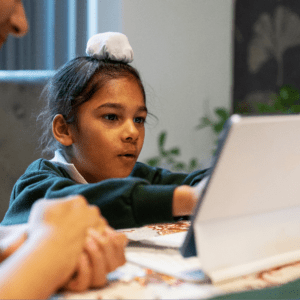As teachers, we know that asking questions is important. Questions can guide our students, challenge them, or support them to do the best that they can.
Asking questions isn’t just about getting students thinking, however. Asking the right question at the right time can help guide students’ thinking in new and unexpected directions. It can help them reflect on their own ideas and thinking. These follow-up questions can really help your students shine and build skills that will serve them well in the future.
In this article, we will explore what follow-up questions are, why you should use them, when you would want to use them, and provide some examples of what they could look like in the classroom.
What is a follow-up question?
A follow-up question is a question that is asked after an initial question has been answered. They could be used to prompt a student to expand on an idea, or challenge them to justify their initial answer. They can be used to build a student’s idea into something that they can use, or challenge a gifted student to push further.
Follow-up questions often begin with phrases like “Can you tell me more about,” “How did you come to that conclusion,” or “What led you to that idea?”

Why should you use follow-up questions?
Follow-up questions are a powerful tool for teaching and learning because they:
- Encourage deeper thinking
- Provide opportunities for clarification
- Encourage participation
- Foster critical thinking skills
Asking targeted follow-up questions can demonstrate to a student that you are really paying attention and care about the work that they are doing. It is a great way to encourage enthusiasm and pride in their work.
See more: Engagement – How do we Know if Our Students are Learning?
When should you use follow-up questions?
Follow-up questions can be used in a variety of situations, including:
- During class discussions
- When assessing understanding
- When providing feedback
- During small group work
Making sure to ask good follow-up questions when a student presents you with an idea can allow you to really assess their thinking. If you ask a probing follow-up question on a student’s work, you can see if they’ve thought deeply about their topic.

Examples of follow-up questions:
Here are some examples of follow-up questions that you could use in your classroom:
“Can you tell me more about how you came to that conclusion?”
“What led you to that idea?”
“Can you provide an example to support your thinking?”
“How does your idea connect to what we learned in class?”
“Can you explain your thinking in more detail?”
“What other ideas could support your argument?”
“Can you tell me more about how you arrived at your solution?”
In conclusion, follow-up questions are a valuable tool for teachers to encourage deeper thinking, provide opportunities for clarification, encourage participation, and foster critical thinking skills. By incorporating follow-up questions into classroom discussions, assessments, feedback, and small group work, teachers can provide opportunities for students to expand on their ideas, reflect on their own thinking, and develop the critical thinking skills they need to be successful in school and beyond.





